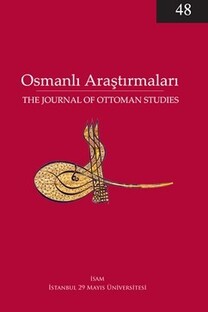Scholars and mobility: A preliminary assessment from the perspective of al-Shaqāyiq al-Numāniyya
Osmanlı ilmiye dünyasının oluşumunda Osmanlı topraklarının dışından gelen veya Osmanlı ülkesini terk edip geri dönen alimler önemli bir rol oynamışlardır. Geri dönmeyip gittikleri yerlerde kaldıkları zaman bile İslâm dünyasının başka yerlerindeki ilmi düzenlere katkıda bulundukları için (coğrafi) hareketlilikleri kayda değerdir. Alimlerin coğrafi hareketlilikleri İslâm dünyasının çeşitli bölgelerindeki ilmi düzenlerin oluşumlarıyla doğrudan ilgili olduğu halde bu konuya şu ana kadar layık olduğu dikkat verilmemiştir. Bu makale Taşköprülüzādenin (v. 968/1561)
Alimler ve hareketlilik: Eş-Şakāyıkun-Numāniyye perspektifinden bir ön değerlendirme
In the formation of the Ottoman learned establishment scholars who came from outside of Ottoman territories played an important role. Scholars who left the Ottoman territories also had a share in this if they came back, and even when they did not their mobility was significant since they contributed to the learned cultures in other parts of the Islamic world. Although mobility of scholars is directly related with formation of learned cultures in various parts of the Islamic world this subject has not been given due attention until now. This paper attempts to draw a sketch of the scholarly mobility issue in the reigns of first ten Ottoman rulers through an analysis of Tashköprülüzādes (d. 968/1561) al-Shaqāyiq al-Numāniyya. It points at the main trends in the mobility of scholars over a period of more than two hundred years and gives brief a discussion of the possible reasons explaining these trends.
___
Ahmed Refik: Onaltıncı Asırda Istanbul Hayatı (1553-1591). Istanbul: 1935.Akpınar, Cemil: Fethullah eş-Şirvani, Türkiye Diyanet Vakfı İslâm Ansiklopedisi.
Aktepe, M. Münir: Taşköpri-zâde, İslâm Ansiklopedisi. Milli Eğitim Bakanlığı.
Anooshahr, Ali: Writing, Speech and History for an Ottoman Biographer, Journal of Near Eastern Studies 69/1, (2010), pp. 43-62.
Arslan, Ali: Osmanlılarda Coğrafi Terim Olarak Acem Kelimesinin Manası ve Osmanlı- Türkistan Bağlantısındaki Önemi (XV-XVIII. Yüzyıllar), Osmanlı Tarihi Araştırma ve Uygulama Merkezi Dergisi 8, (1999), pp. 83-87.
Atçıl, Abdurrahman: The Formation of the Ottoman Learned Class and Legal Scholarship (1300-1600). Ph.D. diss., University of Chicago, 2010.
Clayer, Nathalie: Mystiques, État et Société: Les Halvetis dans lAire Balkanique de la Fin du XVe Siècle à nos Jours. Leiden: E.J. Brill, 1994.
Faroqhi, Suraiya: Social Mobility in the Late Sixteenth Century, International Journal of Middle Eastern Studies 4, (1973), pp. 204-218.
Fleischer, Cornell: Tarihçi Mustafa Ali: Bir Osmanlı Aydın ve Bürokratı. Istanbul: Tarih Vakfı 1996.
Flemming, Barbara: Glimpses of Turkish Saints: Another Look at Lāmiī and Ottoman Biographers, Journal of Turkish Studies 18, (1994), pp. 59-74.
Flemming, Barbara: Iŝām al-Dīn Aģmed b. Muŝafā b. Kĥall, Abul-Kĥayr, the fourth in the line, theologian and biographer, d. 968/1561, in aśĥköprüzāde, Encyclopaedia of Islam, second edition. Brill Online , 2012. Reference. Oxford University libraries. 02 November 2012.
İnalcık, Halil: Murād II, İslâm Ansiklopedisi. Milli Eğitim Bakanlığı. Karabela, Mehmet Kadri: The Development of Dialectic and Argumentation Theory in Post-classical Islamic Intellectual History. Ph.D. diss., McGill University, 2010.
Kissling, Hans J.: Badr al-Dīn b. Kādī Samāwnā, Encyclopaedia of Islam, second edition. Brill Online, 2012. Oxford University libraries. 16 October 2012. http:// referenceworks.brillonline.com/entries/encyclopaedia-of-islam-2/badr-al-din-bkadi- samawna-SIM_1017
Majer, Hans G.: Sozialgeschichtliche Probleme um ulamā und Derwische im Osmanischen Reich, I. Milletler Arası Türkoloji Kongresi (Istanbul 15-20.X.1973) Tebliğler, Istanbul: Istanbul Üniversitesi Edebiyat Fakültesi Enstitüsü 1979, pp. 218-233.
Majer, Hans G.: Vorstudien zur Geschichte der İlmiye im Osmanischen Reich: Zu Uşakīzade, seiner Familie, und seinem Zeyl-i Şakayik. München: Rudolf Trufenik 1978.
Ökten, Ertuğrul: Jāmī (817-898/1414-1492): His Biography and Intellectual Influence in Herat. Ph.D. diss., University of Chicago, 2007.
Repp, Richard: The Mufti of Istanbul. London: Ithaca Press 1986.
Repp, Richard: Some Observations on the Development of the Ottoman Learned Hierarchy, Scholars, Saints and Sufis, (ed.) Nikki Keddie, Berkeley, London: University of California Press 1972, pp. 17-32.
Sohrweide, Hanna: Dichter und Gelehrte aus dem Osten im Osmanischen Reich (1453-1600) Ein Beitrag zur türkisch-persischen Kulturgeschichte, Der Islam 46, (1970), pp. 263-302.
Sohrweide, Hanna: Gelehrte Scheiche und Sufische Ulema im Osmanischen Reich, Studien zur Geschichte und Kultur des Vorderen Orients: Festschrift für Bertold Spuler zum siebzigsten Geburtstag, Leiden: E.J. Brill 1981, pp. 375-386.
Taşköprülüzāde: Al-Shaqāyiq al-Numānīya fī Ulamā al-Dawlat al-Uthmānīya. Ahmed S. Furat (ed.). Istanbul: Istanbul Üniversitesi Edebiyat Fakültesi. Fak. Yayınları 1985.
Uğur, Ali: Taşköprî-zâde Ahmed Efendi, Osmanlı Araştırmaları 7-8, (1988), pp. 419-37.
Ulusoy, Ahmed: Kuruluşundan 17. Yüzyıla Kadar Osmanlı Medreselerinde EğitimÖğretim Faaliyetleri. M.A. thesis, Selçuk University, 2007.
Uzunçarşılı, İsmail H.: Osmanlı Devletinin İlmiye Teşkilatı. Ankara: Türk Tarih Kurumu Yayınları 1965.
Ünver, A. Süheyl: Istanbul Üniversitesi Tarihine Başlangıç: Fatih Külliyesi ve Zamanı İlim Hayatı. Istanbul: Istanbul Üniversitesi Yayınları 1946.
Zilfi, Madeline: The Politics of Piety: The Ottoman Ulamā in the Post Classical Age (1600- 1800). Minneapolis: Bibliotheca Islamica 1988.
- ISSN: 0255-0636
- Yayın Aralığı: Yılda 3 Sayı
- Başlangıç: 1980
- Yayıncı: TDV İslâm Araştırmaları Merkezi
Sayıdaki Diğer Makaleler
Türkçe mektupları ışığında ebussuûd efendi'nin Beşerî münâsebetleri
Türk Eğitim Düşüncesi ve Deneyiminin Dönüm Noktaları Üzerine Bir Çözümleme
Osmanlı Paşalarının Mahiyetindeki Değişim: Mukayeseli Tarih Bakımından Bir Değerlendirme
Braudel'den Sonra Akdeniz ve Akdeniz Dünyası: Faruk Tabak'ın Solan Akdeniz'i Üstüne
Scholars and mobility: A preliminary assessment from the perspective of al-Shaqāyiq al-Numāniyya
Farklılıkları bağlamında Osmanlı İstanbul'unda İthalat: İzmir ile bir karşılaştırma (1793-1803)
